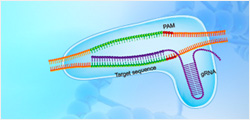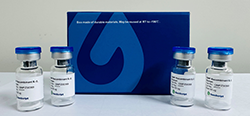Epstein-Barr virus (EBV) is one of the most common viruses in humans, capable of causing life-threatening infections and cancers in immunocompromised individuals. Although CD8+ T-cells provide key protection against EBV, persistence of specific T-cell receptor (TCR) clones during immunosuppression in transplant patients is largely unknown. For the first time, we used a novel single-cell TCR multiplex-nested RT-PCR to dissect TCR clonal diversity within GLCTLVAML-specific CD8+ T-cells in healthy individuals and immunocompromised lung transplant recipients. GLCTLVAML (GLC) peptide presented by HLA-A*02:01 is one of the most immunogenic T-cell targets for EBV. We found that the GLC-specific TCR r... More
Epstein-Barr virus (EBV) is one of the most common viruses in humans, capable of causing life-threatening infections and cancers in immunocompromised individuals. Although CD8+ T-cells provide key protection against EBV, persistence of specific T-cell receptor (TCR) clones during immunosuppression in transplant patients is largely unknown. For the first time, we used a novel single-cell TCR multiplex-nested RT-PCR to dissect TCR clonal diversity within GLCTLVAML-specific CD8+ T-cells in healthy individuals and immunocompromised lung transplant recipients. GLCTLVAML (GLC) peptide presented by HLA-A*02:01 is one of the most immunogenic T-cell targets for EBV. We found that the GLC-specific TCR repertoire was heavily biased towards TRAV5 and encompassed five classes of public TCRs, suggesting that these clonotypes are preferentially utilized following infection. We identified that a common TRAV5 was diversely paired with different TRAJ and TRBV/TRBJ genes, in both immunocompetent and immunocompromised individuals, with an average of 12 different TCR clonotypes/donor. Moreover, pretransplant GLC-specific TCR repertoires were relatively stable over 1-year post-transplant under immunosuppression in the absence or presence of EBV reactivation. Additionally, we provide the first evidence of early GLC-specific CD8+ T-cells at 87 days post-transplant, which preceded clinical EBV detection at 242 days in an EBV-seronegative patient receiving a lung allograft from an EBV-seropositive donor. This was associated with a relatively stable TCR repertoire after CD8+ T-cell expansion. Our findings provide insights into the stability of EBV-specific TCR repertoire in immunocompromised transplant patients and suggest that the early detection of EBV-specific T-cells might be a predictor of preceding EBV blood viremia.



































